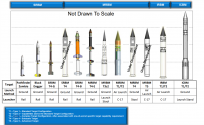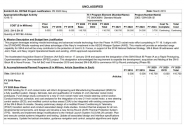Just take it as a patriotic education museum.T
They look like they had a fun time, but I've always been leery about children being close to military matters.
You are using an out of date browser. It may not display this or other websites correctly.
You should upgrade or use an alternative browser.
You should upgrade or use an alternative browser.
055 Large Destroyer Thread II
- Thread starter Blitzo
- Start date
Kids are only seeing a cool warship, like when dad once snuck me into the base in the back seat to look at submarinesT
They look like they had a fun time, but I've always been leery about children being close to military matters.
They'll be excited just to be outside of classrooms. It's like going to the zoo for them.
Yes, YJ-21 is not a pure ballistic missile, and that's exactly why terminal speed differs.
You can decomposite the force into vertical and horizontal ones.
More ratio on vertical increases your terminal speed, and more ratio on horizontal increases your range.
A pure ballistic missile maximizes the horizontal ratio, and the fastest DF-41 is by launching at 90 degrees, converting all fuel into terminal speed but will travel 0 km.
The problem with 055's VLS is that it is still too small. It inserts smaller missile which internal fuel is inadequate for a 2500km operation. Why YJ-21 is hard to intercept? The essence is its speed plus a non-ballistic trajectory. Both of these are fulfilled by sacrificing the maximal range, which is ~ 1500 km. The grand tactic for modern ASBM strike is to launch different trajectories of missiles, overwhelming enemies' BMD system calculation capability at an untouchable range.
Therefore, future 055 variants with shipboard DF-17/26/27 still do a better job than YJ-21.
Well, if picrel are the frame of the UVLS module then the UVLS has potential to go as deep as 11-12m, meaning you can potentially fit missiles the size of DF-17.
If I had to guess, the reason for why we don't have 12m UVLS is prob because the cold launch system for a 0.83x 11m missile is unreliable since the shape is very long and thin. Future EM UVLS perhaps?

That requires a huge ship with the size of Pr 1144 on one hand, and in the other ballistic path makes those DF17/26 extremely vulnerable to SM6, so I think it has not that much sense. H20 and stealth cruise missiles can reach that extreme ranges.LRASM has 900km range, F-35C has 500km. Together is nearly 1500km, which is somewhat equivalent to YJ-21 or even exceeding. (Recall longer range for YJ-21 implies slower terminal speed and thus a better chance for SM-6 to intercept.)
Therefore, if talking about a decisive battle outside the 2nd island chain, say Hawaii or even near California, it is reasonable to have a shipboard version of DF-26. The range is around 2500km, far exceeding the range of a CSG. This will likely put an end to CSG tactics and reincarnate the "capital ships".
So what's happening to future 055 variants? To insert something like DF-17/26 you will definitely need a larger VLS cell, which might even be capable of quad-packing HHQ-9B, nona-packing HHQ-16F due to universal properties. So the ship hull as well as tonnage increases to equip such cells.
There is no proof whatsoever that SM6, even in mass numbers, could down just a few DF26 let alone DF17.That requires a huge ship with the size of Pr 1144 on one hand, and in the other ballistic path makes those DF17/26 extremely vulnerable to SM6, so I think it has not that much sense. H20 and stealth cruise missiles can reach that extreme ranges.
US doesn't even have equivalent tech missiles, but if they did, they would conduct shoot down tests similar to what China did with its own HQ19, to prove that they have the capability. Which they haven't.
The main limitation of DF26 is just the targeting process.
I'm sorry but this is just plain wrong.US doesn't even have equivalent tech missiles, but if they did, they would conduct shoot down tests similar to what China did with its own HQ19, to prove that they have the capability. Which they haven't.


I wish to not resurface so early but really people here have to tone down the anti-america rhetorics.
As non-maneuvering RVs are essentially different only in their reentry phase ( boost scales to speed and altitude, which determines both ToT, reentry speed and trajectory), unless DF-26 has mini-decoys stuffed into the payload bus, I'd place it alongside the likes of the other MRBM/IRBM-class targets the USN has tested, and against which the USN has demonstrated the the current IA is adequate enough. Further for consideration is the growth potential: the current SM-6 use is really dated from a pure search/track capability viewpoint, as it reuses the AMRAAM-C mechanical planar array.
The new IB would replace DTRM with SM-3 IIA 21in motor which would give it at least a range of 1000miles with a ballistic ground attack trajectory so as to conform to MRC, and would be able to intercept hypersonics of some kind

I'd lowball said capability to something like HERA but that is still a conical MaRV albeit rather ancient.
But that's pure propulsion, an updated to something resembling an actual AESA seeker, D7 ECCM and brief targeting from an E-2D would be a fairly serious threat to J-35 attack ships, H-6K and DF-26s while GPIs and SM-3s are reserved for PLARF HGVs.
I'd support expanding UVLS capability solely for using HGV-tipped missiles really. Hypersonic is one domain where the PLA can offer significant, if not colossal, quantitive overmatch ( SM-6 current production rate is like "dozen-a year").
Attachments
But that capability is no different from hq9 in terms of hitting ballistic missiles before they go through reentry.I'm sorry but this is just plain wrong.
View attachment 122199
View attachment 122200
I wish to not resurface so early but really people here have to tone down the anti-america rhetorics.
As non-maneuvering RVs are essentially different only in their reentry phase ( boost scales to speed and altitude, which determines both ToT, reentry speed and trajectory), unless DF-26 has mini-decoys stuffed into the payload bus, I'd place it alongside the likes of the other MRBM/IRBM-class targets the USN has tested, and against which the USN has demonstrated the the current IA is adequate enough. Further for consideration is the growth potential: the current SM-6 use is really dated from a pure search/track capability viewpoint, as it reuses the AMRAAM-C mechanical planar array.
The new IB would replace DTRM with SM-3 IIA 21in motor which would give it at least a range of 1000miles with a ballistic ground attack trajectory so as to conform to MRC, and would be able to intercept hypersonics of some kind
View attachment 122202
I'd lowball said capability to something like HERA but that is still a conical MaRV albeit rather ancient.
But that's pure propulsion, an updated to something resembling an actual AESA seeker, D7 ECCM and brief targeting from an E-2D would be a fairly serious threat to J-35 attack ships, H-6K and DF-26s while GPIs and SM-3s are reserved for PLARF HGVs.
I'd support expanding UVLS capability solely for using HGV-tipped missiles really. Hypersonic is one domain where the PLA can offer significant, if not colossal, quantitive overmatch ( SM-6 current production rate is like "dozen-a year").
As far as I know (I appreciate correction as I'm not an expert by any means), there is no reliable way to complete a kill chain on a missile before it reenters atmosphere, barring extreme cases such as the launch area being heavily surveyed and an interceptor can be launched while the missiles is still boosting.
Similar to other modern AAM, they can indeed hypothetically shoot down a Df17 if they hit it before it exits the atmosphere. How realistic is this when you'd need ISR that predicts the site and exact moment of launch, have a platform to direct the SM6 past its radar horizon, and launch it close enough to catch up?
Also this isn't anti American agenda or whatever. I would also not believe that hq-9/19 can reliably intercept LRHW once it comes out. Because of above outlined reasons.
Yes.there is no reliable way to complete a kill chain on a missile before it reenters atmosphere, barring extreme cases such as the launch area being heavily surveyed and an interceptor can be launched while the missiles is still boosting.
IB's ground-attack range, at minimum, is like 1000miles. Because it use a full-bore body, the chords/strakes are removed and along with it the coast-glide profile of the later SM-1/2s which enabled them to reach such ranges. RIM-156 could intercept 2 times farther than RIM-67D despite being 2/3 the length, booster included.
So it ranges against an plane-like target would be around 500miles-ish, and I'm ballparking THAAD-like performance against BMs ( ERAM was conceived to fill in the TBMD defense gap after IVA was cancelled, so it's terminal-phase only).
Boost-phase would be the job of GPI which is still conceptual.
It doesn't need to, of course.Similar to other modern AAM, they can indeed hypothetically shoot down a Df17 if they hit it before it exits the atmosphere. How realistic is this when you'd need ISR that predicts the site and exact moment of launch, have a platform to direct the SM6 past its radar horizon, and launch it close enough to catch up?
ERAM dictates that the usage of SM-6 be relegated to only terminal intercept only, IOW, AWC ships with AMDR-S and SPEIR. The HGV gap is plugged with SM-3 future incarnations, and possibly KEI if APM ever ends up on AMDR/Zumwalt
ships.
As for ISR, satellites can do that, and offensive ASAT often warrants nukes.
Yeah me saying anti-murica is definitely a bit of overreaching on my side but claiming that the US doesn't have equivalent missiles to DF-26/17 is wrong. Think of my post as a rather verbose correction, no offense intended.Also this isn't anti American agenda or whatever. I would also not believe that hq-9/19 can reliably intercept LRHW once it comes out. Because of above outlined reasons.


